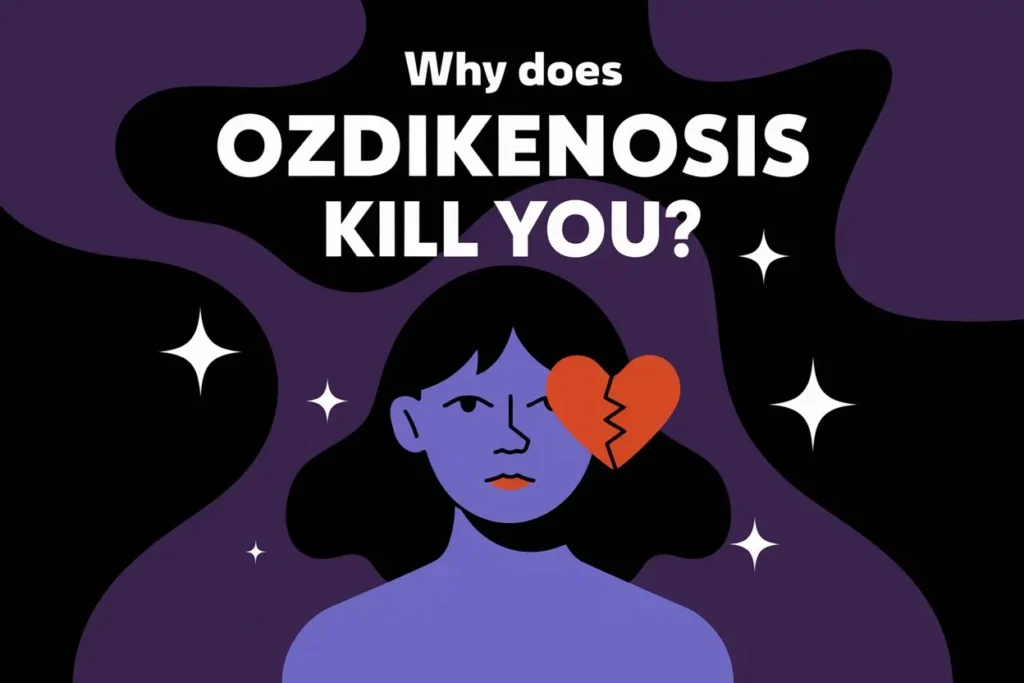Why does ozdikenosis kill you? That question may seem grim, yet it reveals a dark truth about a disease few fully understand. In simple terms, ozdikenosis is a rare and deadly condition that gradually breaks down how your body’s cells and organs work. As it progresses, vital systems fail. Because of those cascading failures, ozdikenosis can lead to death. In this article, we will explain in clear, easy language how and why ozdikenosis kills you.
What Is Ozdikenosis?
Ozdikenosis is a rare genetic or metabolic disorder in which the body slowly loses its ability to manage energy, cell repair, and organ coordination. Patients with ozdikenosis develop problems at the cellular level first, and then those problems spread to tissues and organs. Over time, the damage becomes irreversible, and the body cannot support life.
How Does Ozdikenosis Work at the Cellular Level?
At the heart of “why does ozdikenosis kill you” is what goes wrong inside your cells. In ozdikenosis, mitochondria—the little power plants inside your cells—become dysfunctional and cannot make enough energy (ATP). Also, the mechanisms that clean up waste inside cells (autophagy) fail. As a result, cells accumulate toxic debris. When you lose many cells in critical organs, those organs begin to fail.
Why Does Ozdikenosis Kill You? — The Path to Organ Failure

Once cellular breakdown begins, the disease spreads to organs. The heart, lungs, kidneys, liver, and brain are most vulnerable. As millions of cells in each organ die or malfunction, the organ cannot perform its function. For example, the heart can’t pump enough blood, the kidneys can’t filter waste, the lungs can’t oxygenate blood. That is one of the main reasons “why does ozdikenosis kill you.”
Immune System Breakdown and Infections
Another reason why ozdikenosis kills you is the collapse of the immune system. Because cells responsible for immunity are damaged, the body becomes vulnerable to infections. Even small infections, which a healthy person might manage, can spiral out of control. Sepsis or overwhelming infection can be the final blow.
Metabolic Imbalance and Toxin Build-Up
Ozdikenosis disturbs your body’s metabolism. Toxins that should be broken down by the liver or kidneys start accumulating. Acid–base balance gets disturbed (leading to acidosis). Electrolytes go out of balance. These metabolic troubles stress the organs further and push them closer to failure. Thus, metabolic collapse is another way “why does ozdikenosis kill you.”
Why Does Ozdikenosis Kill You? — The Vicious Feedback Loop
By the time multiple organs begin failing, a vicious cycle begins. Organ failure causes metabolic derangement, which causes more cell death, which worsens organ failure. This feedback loop accelerates the decline. As more systems collapse, survival becomes impossible unless intervention is effective and very early.
Why Treatment Often Fails
You might wonder: if doctors try, why does ozdikenosis kill you anyway? The answer is because treatments are mostly supportive, not curative. Doctors can give medicines to reduce damage, manage symptoms, support organs (like dialysis for kidneys or ventilators for lungs), and fight infections. But they cannot yet correct the fundamental defect in cellular energy production. Once damage becomes widespread, treatment is mostly palliative.
Symptoms That Hint at Why Ozdikenosis Kills You
To understand why ozdikenosis kills you, watch for warning signs early. Some symptoms include:
- Constant and worsening fatigue
- Muscle weakness and loss of strength
- Shortness of breath
- Swelling in limbs or around organs
- Frequent or severe infections
- Jaundice or liver dysfunction
- Confusion or neurological changes
These signs point toward systems struggling. If many appear together, it might be too late to reverse the damage.
Timeline of Disease Progression
Ozdikenosis often advances in stages. At first, damage is mild and silent. Then symptoms begin. After that, organ systems fail one by one. By the terminal stage, multiple systems collapse simultaneously. The earlier you are diagnosed, the better your chance of slowing progression.
Genetic and Risk Factors
What determines who gets ozdikenosis and how fast it kills you? Genetics play a major role. Mutations that impair mitochondrial function or cell cleanup pathways increase risk. Environmental stressors, toxins, poor nutrition, or other diseases may worsen the progression. Unfortunately, once the process begins, it tends to be relentless.
The Emotional Toll and Why It Matters
Part of “why does ozdikenosis kill you” is not just physical damage but emotional burden. Patients and families face anxiety, despair, and stress. Those mental states weaken the body’s resilience further. Caring for someone with ozdikenosis is emotionally draining, which may indirectly affect outcomes.
Can Anyone Survive Ozdikenosis?
Currently, ozdikenosis is described as “universally fatal” in many sources, meaning that without a cure, virtually all patients eventually die. Health Conscious+2thehometrotters.com+2 However, some may live longer with good supportive care, early detection, and symptom management. The goal is quality of life, not cure.
Why Does Ozdikenosis Kill You? — The Bottom Line
The full answer to “why does ozdikenosis kill you” is that it attacks the body from the inside out: cells lose energy, waste accumulates, organs fail, immune defenses collapse, metabolic systems break down, and none of those damages can be fully repaired. The combination of all these failures is what makes ozdikenosis lethal.
Future Research and Hope
Scientists are exploring gene therapy, mitochondrial boosters, and cell repair technologies. These might someday prevent ozdikenosis from killing you. But until then, the best hope lies in early detection, experimental treatments, and supportive care.
Read more: Stewart WavetechGlobal – The Next Generation of Innovative Tech Leadership
FAQ — Why Does Ozdikenosis Kill You?
A: Because it affects many systems at once—cells, metabolism, immunity, organs—and the damage reinforces itself.
A: Sometimes, yes. A sudden infection or organ collapse may rapidly tip a patient into fatal condition.
A: They currently lack ways to fix the root cellular and mitochondrial defects. Treatments are mostly supportive.
A: Yes, with early diagnosis, organ support, infection control, and metabolic management, progression may slow.
A: Because damage tends to spread; early organ failure leads to cascading failures in others.
